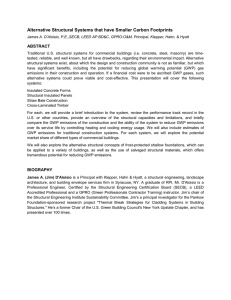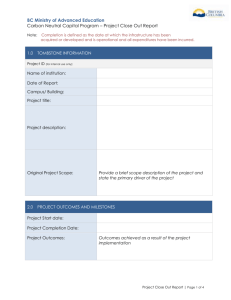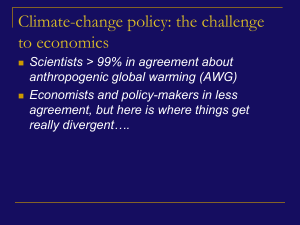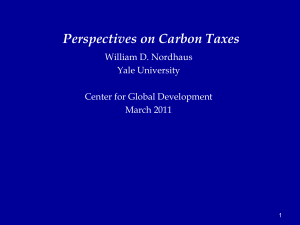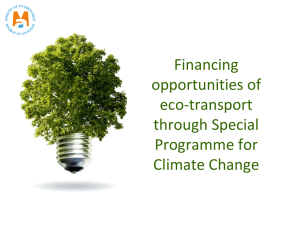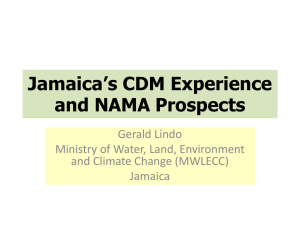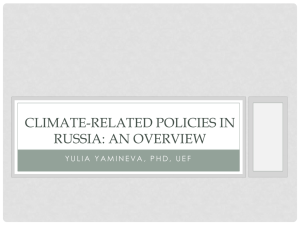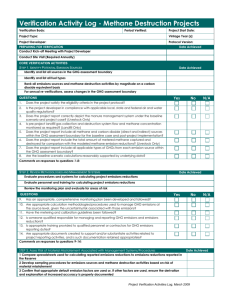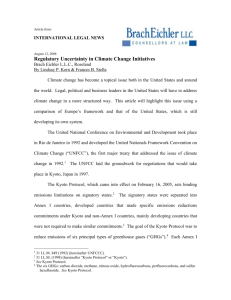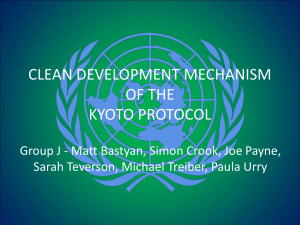Carbon_Carbon_Market
advertisement
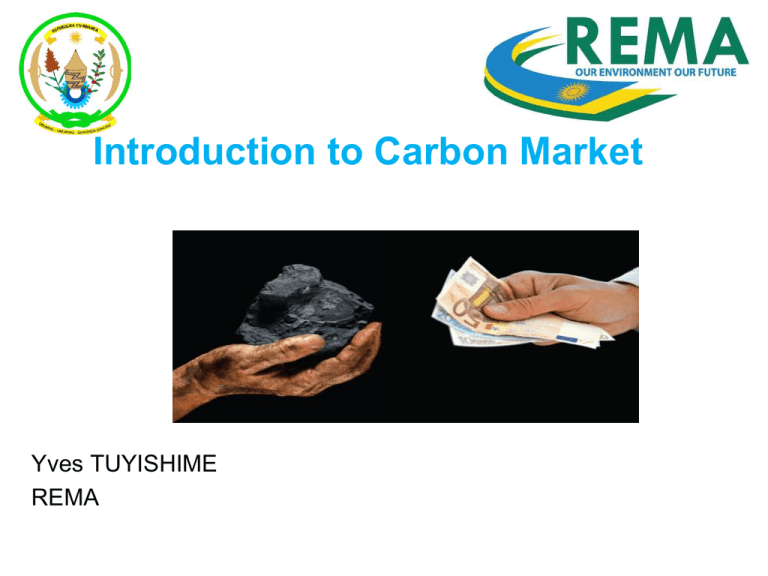
Introduction to Carbon Market Yves TUYISHIME REMA Outline 1. Carbon Market 2. The Clean Development Mechanism (CDM) 3. Kyoto Protocol 4. Carbon Market: Is it happening in Rwanda? CARBON MARKET What is the carbon market? • The carbon market is like any other market, but in this particular market “people” are shopping for “carbon credits” measured in tCO2e. Source: Freefoto.com What is carbon credit? 1 Carbon credit = 1 ton of CO2 • CERs • Emission Reductions Units • Verified Emission Reductions 1 Carbon credit = 1 ton of CO2 Currently the price of one carbon credit varies between 6$ and 8 $ Who are the Buyers & Sellers? Buyers • Compliance buyers, i.e. (big) carbon emitters from developed countries which have commitment to kyoto protocol. • Voluntary buyers, e.g. corporations , e.g. as part of Corporate Social Responsibility initiatives (being “green”), attract potential clients, satisfy eco-conscious shareholders, new investment opportunities, risk management or part of their philosophy individuals, e.g. offset your holiday flight, (NGOs) etc…. Sellers • Developing countries, i.e. Lower emission countries or with large tracks of forests • Developed countries, i.e. countries trading off their surplus in carbon credits Types of Carbon Markets Regulatory Markets - Clean Development Mechanisms -Joint implementation Voluntary Carbon Market Voluntary Market • The voluntary market represents those who wish to compensate voluntarily for emissions associated with their operations–either as part of a commitment to corporate responsibility or to attract green consumers. They have no legal requirement to participate. -Voluntary carbon standard VCS -Plan Vivo -Gold standard, etc…. Regulatory Market - Clean Development Mechanisms - Joint implementation CLEAN DEVELOPMENT MECHANISM (CDM) The Clean Development Mechanism • Flexible mechanism under the Kyoto Protocol • Two goals: • Reduce greenhouse gas emissions • Assist sustainable development in developing countries • Cooperation between Annex-1 countries and non-Annex 1 countries Kyoto Protocol Establishes legally binding commitments for the reduction of GHGs Adopted in 1997, Ratified in July 2004, entered into force in February 2005,and had to expire in 2012 (As of august 2011,191 Countries are parties to KP) Protocol to the 1992 UN Framework Convention on Climate Change (UNFCCC) Requires Annex 1 countries (West and Eastern Europe, North America, Japan, New Zealand, Australia – industrialised countries) to reduce overall emissions of greenhouse gases by at least 5.2% during 2008 – 2012 Voluntary participation of Non-Annex 1 countries (China, India, etc. – “developing countries”) Clean Development Mechanism (CDM) involves Annex 1 and non-Annex 1 countries GHGs covered by KP cont… GHG Description Carbon Dioxide(CO2) The most Important GHG Generated from fossil fuel burning and deforestation Methane(CH4) Comes from landfills, coal mines, oil and natural gas operations and agriculture Nitrous Oxide(NH20) Emitted from the use of nitrogen fertilizers, from burning fossil fuels and some industrial and waste management processes Sulfur-hexafluoride (SF6) Used in electrical insulator, freezing agent and heat conductor Hydro-fluorocarbons(HFCs) and These are groups of gazes used as alternative to ozone-depleting in refrigeration systems Per fluorocarbons (PFCs) GHGs covered by the KP Sulphur hexafluoride (SF6) GWP: 23,900 Methane (CH4) GWP: 21 Nitrous oxide (N2O) Carbon dioxide (CO2) GWP: 310 GWP: 1 Hydrofluorocarbons (HFCs) Perfluorocarbons (PFCs) GWP:11,700 GWP: 9,200 Each GHG has a different Global Warming Potential INTRODUC TION TO CDM Eligibility criteria 1. 2. 3. 4. 5. 6. Reduction in GHG Emissions covered by the KP Host country (Rwanda) must be a Party to the Kyoto Protocol Contribution to Sustainable Development of Rwanda Additionality Emission reduction must be real, measurable and long term Sector must be eligible Eligible sectors • • • • • • • • • • • • Energy industries (Production &Distribution) Manufacturing industries Construction Transport Mining/mineral production Metal production Fugitive emissions from fuels (solid, oil and gas) Fugitive emissions from production and consumption of halocarbons and sulphur hexafluoride Solvent use Waste handling and disposal Afforestation and reforestation Agriculture How does it work? Non-Annex I Annex I Carbon value (€) Buyer Emissions reductions needed Emissions reductions target Emissions reductions achieved Seller Certified Emissions Reductions (CERs) How to develop a CDM project and create carbon credits? Project Idea Project Note Design (PP) Document (PP) Host Country Approval (DNA) Registration (EB) Implementation & Monitoring (PP) Validation (DOE) Verification (DOE) Issuance (EB) Legend DNA Designated National Authority DOE Designated Operational Entity PP Project Participants EB CDM Executive Board CERs Certified Emission Reductions (Validator / Verifier) C E R S Is it happening in Rwanda? 23 CDM projects in pipeline • • • • improved cookstove projects water purification hydropower efficient lighting projects: Solar lighting Rechargeable light by pedal machine CFL project rwandadna@gmail.com www.rema.gov.rw/dna
